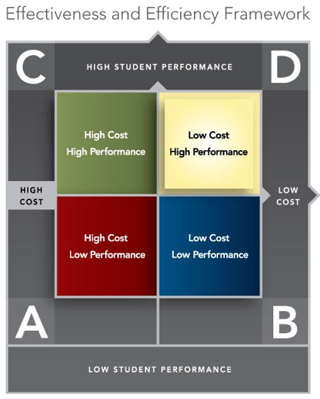
In the current climate of education—at least in my state—accountability is at an all-time high while financial support is at a historic low. Every teacher I know is working with fewer resources and more challenges each year. What is a school to do?
 Combining Effectiveness and Efficiency in the Classroom
Combining Effectiveness and Efficiency in the Classroom
Bill Daggett, founder of the International Center for Leadership in Education, is a leading voice in the area of effective and efficient school practice. In his Effectiveness and Efficiency Framework, Classroom Looping is second on the list of examples of practices to consider. This means that it falls in quadrant D in the framework pictured to the right. He cites this as a low-cost, but high-effect, approach for schools. Interestingly, “technology” is the third example on his list. Even though there is up-front cost to engaging classroom tools, the impact on student achievement is worth the cost.
Is Looping the Right Choice for Your Classroom?
So, as a teacher or school leader reading this, here are some things to consider about looping:
What exactly are we talking about when we use the term “Classroom Looping?”
Looping is defined as a teacher spending two or more years with the same group of classroom students. We typically see looping classrooms in the 3rd to 5th grade range, but there is good evidence that looping is very effective with transition years, when students go to middle school or high school.
What are the advantages?
There are some obvious advantages to looping. Students and teachers have established relationships going into the second year. Students know one another well and are connected to the school from day one. The teacher knows their students’ learning styles and personality types, which helps assist with grouping students and meeting students’ needs.
Also, the teacher has the opportunity to engage parents and get to know them more deeply over the two-year cycle. There is also opportunity for teachers to engage students over the summer, either with projects or just for social connection. Plus, there are higher levels of job satisfaction for teachers when developing long-lasting relationships with students.
What are the disadvantages?
There are potential downsides to looping, with the number one parent concern being, “What if I get ‘stuck’ with a bad teacher.” Because we know the negative impact that one year with an ineffective teacher can have, it would double the impact for two years. This concern is valid, but not a deal-breaker for a school. We shouldn’t allow any teacher to be ineffective—all teachers should be “ready to loop” and given the necessary support to be better at the process.
Another disadvantage could be the teacher’s need to learn two years’ worth of curricula. It takes time to learn, so this is a real consideration when making a decision.
What impact does Classroom Looping have on achievement?
Numerous research studies have shown positive outcomes in looping classrooms. Attendance and achievement both surpassed peer groups in this Florida study. This list of research from Brown University is a little older, but provides good support for looping. Keep in mind that typically outcomes are good because high-quality teachers are the ones chosen to loop (or who themselves have volunteered). Despite this, it is still worth considering.
Key Factors and Considerations
Teachers, when willing, tend to support looping: Any teacher I have known that looped with students swears by it. I personally do not believe that it works for every teacher, but I do believe teachers who are willing to try—and are supported by administration—can have great success with it.
It does take some resources: Just moving the 4th graders onto the 5th grade in the same classroom isn’t quite enough. When a teacher is willing to loop, they need resources and training for the curriculum of the other year. Don’t assume a great teacher is enough to be successful.
Consider looping for transitional years: The team approach to middle schools lends itself, at least structurally, to consider looping. As students get older—and the content and standards get harder—it is more difficult to move from one curriculum to the next. Administrators should consider the workload this creates and possible other issues when it comes to qualifications and licenses. A time when schools are most likely to allow students to “fall through the cracks” should be the exact time when we support them the most.
As a principal, I believe it is clear that with willing, effective teachers, looping can have a positive impact on students with minimal cost to the school and district. When every dollar counts and we have to count every dollar, educators must continue to consider new, effective ways to make a difference in the lives of our students.
What are your thoughts? Share your comments with us below.


